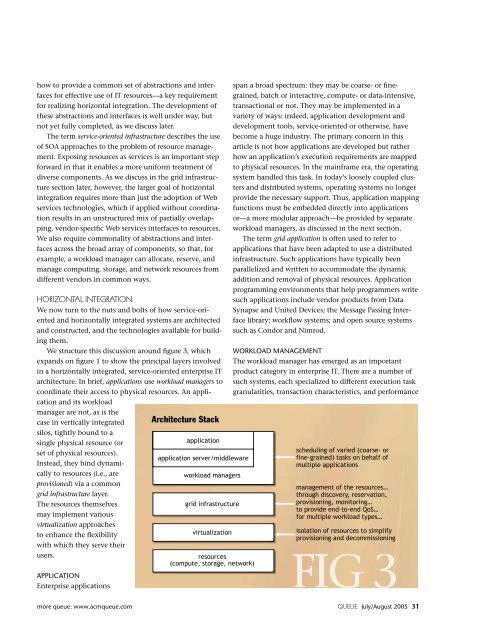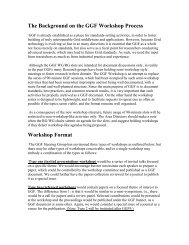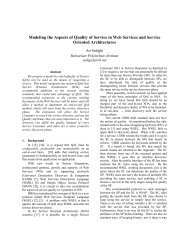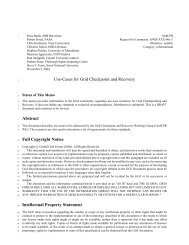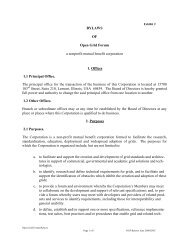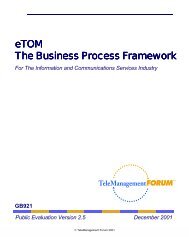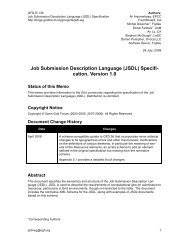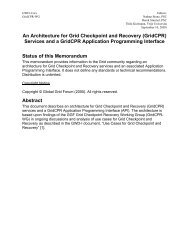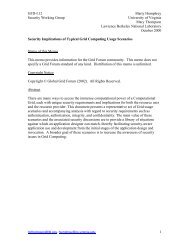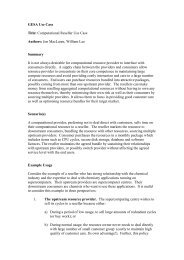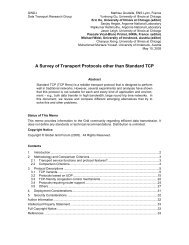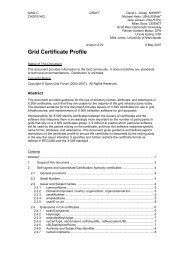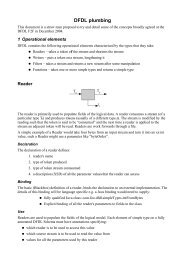Describing the Elephant - ACM Digital Library
Describing the Elephant - ACM Digital Library
Describing the Elephant - ACM Digital Library
You also want an ePaper? Increase the reach of your titles
YUMPU automatically turns print PDFs into web optimized ePapers that Google loves.
how to provide a common set of abstractions and interfaces<br />
for effective use of IT resources—a key requirement<br />
for realizing horizontal integration. The development of<br />
<strong>the</strong>se abstractions and interfaces is well under way, but<br />
not yet fully completed, as we discuss later.<br />
The term service-oriented infrastructure describes <strong>the</strong> use<br />
of SOA approaches to <strong>the</strong> problem of resource management.<br />
Exposing resources as services is an important step<br />
forward in that it enables a more uniform treatment of<br />
diverse components. As we discuss in <strong>the</strong> grid infrastructure<br />
section later, however, <strong>the</strong> larger goal of horizontal<br />
integration requires more than just <strong>the</strong> adoption of Web<br />
services technologies, which if applied without coordination<br />
results in an unstructured mix of partially overlapping,<br />
vendor-specific Web services interfaces to resources.<br />
We also require commonality of abstractions and interfaces<br />
across <strong>the</strong> broad array of components, so that, for<br />
example, a workload manager can allocate, reserve, and<br />
manage computing, storage, and network resources from<br />
different vendors in common ways.<br />
HORIZONTAL INTEGRATION<br />
We now turn to <strong>the</strong> nuts and bolts of how service-oriented<br />
and horizontally integrated systems are architected<br />
and constructed, and <strong>the</strong> technologies available for building<br />
<strong>the</strong>m.<br />
We structure this discussion around figure 3, which<br />
expands on figure 1 to show <strong>the</strong> principal layers involved<br />
in a horizontally integrated, service-oriented enterprise IT<br />
architecture. In brief, applications use workload managers to<br />
coordinate <strong>the</strong>ir access to physical resources. An application<br />
and its workload<br />
manager are not, as is <strong>the</strong><br />
case in vertically integrated<br />
silos, tightly bound to a<br />
single physical resource (or<br />
set of physical resources).<br />
Instead, <strong>the</strong>y bind dynamically<br />
to resources (i.e., are<br />
provisioned) via a common<br />
grid infrastructure layer.<br />
The resources <strong>the</strong>mselves<br />
may implement various<br />
virtualization approaches<br />
to enhance <strong>the</strong> flexibility<br />
with which <strong>the</strong>y serve <strong>the</strong>ir<br />
users.<br />
APPLICATION<br />
Enterprise applications<br />
Architecture Stack<br />
application<br />
application server/middleware<br />
workload managers<br />
grid infrastructure<br />
virtualization<br />
resources<br />
(compute, storage, network)<br />
span a broad spectrum: <strong>the</strong>y may be coarse- or finegrained,<br />
batch or interactive, compute- or data-intensive,<br />
transactional or not. They may be implemented in a<br />
variety of ways: indeed, application development and<br />
development tools, service-oriented or o<strong>the</strong>rwise, have<br />
become a huge industry. The primary concern in this<br />
article is not how applications are developed but ra<strong>the</strong>r<br />
how an application’s execution requirements are mapped<br />
to physical resources. In <strong>the</strong> mainframe era, <strong>the</strong> operating<br />
system handled this task. In today’s loosely coupled clusters<br />
and distributed systems, operating systems no longer<br />
provide <strong>the</strong> necessary support. Thus, application mapping<br />
functions must be embedded directly into applications<br />
or—a more modular approach—be provided by separate<br />
workload managers, as discussed in <strong>the</strong> next section.<br />
The term grid application is often used to refer to<br />
applications that have been adapted to use a distributed<br />
infrastructure. Such applications have typically been<br />
parallelized and written to accommodate <strong>the</strong> dynamic<br />
addition and removal of physical resources. Application<br />
programming environments that help programmers write<br />
such applications include vendor products from Data<br />
Synapse and United Devices; <strong>the</strong> Message Passing Interface<br />
library; workflow systems; and open source systems<br />
such as Condor and Nimrod.<br />
WORKLOAD MANAGEMENT<br />
The workload manager has emerged as an important<br />
product category in enterprise IT. There are a number of<br />
such systems, each specialized to different execution task<br />
granularities, transaction characteristics, and performance<br />
scheduling of varied (coarse- or<br />
fine-grained) tasks on behalf of<br />
multiple applications<br />
management of <strong>the</strong> resources…<br />
through discovery, reservation,<br />
provisioning, monitoring…<br />
to provide end-to-end QoS…<br />
for multiple workload types…<br />
isolation of resources to simplify<br />
provisioning and decommissioning<br />
FIG 3<br />
more queue: www.acmqueue.com<br />
QUEUE July/August 2005 31


